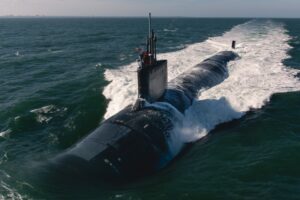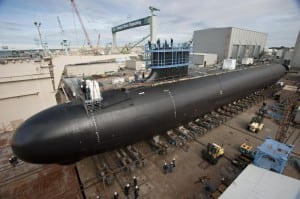Australian sailors and shipbuilders have to participate in American operations and construction to learn how to build and operate their own nuclear-powered submarines as part of the AUKUS agreement, a key lawmaker said Tuesday.
Speaking during a Center for Strategic and International Studies event on July 26, Rep. Rob Wittman (R-Va.), ranking member of the House Armed Services subcommittee on seapower and projection forces, said he and subcommittee chairman Rep. Joe Courtney (D-Conn.) have talked with Adm. James Caldwell, director of the naval nuclear propulsion program.
Wittman said the cooperation has to start with Australian sailors coming to the U.S. to train at the U.S. Navy’s nuclear school and deploy on U.S. submarines.
“Can’t do it any other way, you can’t bring them over and say we’ll give you a little dog and pony show, we’ll give you a short course in nuclear science and nuclear engineering. They have to go through the nuke school, they have to deploy on our nuclear submarines to understand what those deployments are about. Those efforts are underway.”

Last September, the U.S., U.K., and Australia first announced the new partnerships to help Australia buy a new class of nuclear-powered submarines to replace its current fleet of six Collins-class conventional diesel-electric powered submarines (Defense Daily, Sept. 15, 2021).
The partners have started the process with an 18-month exploratory review period to help inform Australia’s government on how to pursue the capability.
Wittman’s focus on personnel training is reflected in a provision he helped add to the House’s version of the fiscal year 2023 defense authorization bill, which would establish a joint training pipeline to help train Australian nuclear mariners. The bill would allow Australia to send at least two submarine officers to train with the U.S. Navy annually, including full training at the Navy Nuclear propulsion School, Submarine Officer Basic Course and assigned duty on an operational U.S. submarine (Defense Daily, June 17).
However, this week Wittman underscored other parts of the Australian Navy and industrial base have to become embedded in the U.S. nuclear naval workforce as well to achieve the goals of AUKUS.
“Also, Australian shipbuilders can’t just come here for a dog and pony show, they have to come here and work in the yards, both at Newport News and Electric Boat…They have to be there in the yards, they have to be hands-on building those nuclear submarines. Their engineers and naval architects have to come here shoulder to shoulder with our engineers and naval architects,” he said.
The U.S. Virginia-class attack submarines are jointly built by HII’s Newport News Shipbuilding [HII] and General Dynamics Electric Boat [GD]. Each company builds certain parts of each boat and they take turns building the reactors and performing final assembly for each vessel.
Moreover, Wittman said the Australian officials have to not only understand the design elements of the U.S. Virginia-class attack submarine, but “they have to also understand what’s going into SSN(X) as we look to design future classes of submarines. Not any of the classified information, I want to be clear about, but what the principles of engineering and physics and naval architecture are and how we go about that process. Those things I think are incredibly important.”
Wittman said these things have to start now because Australia’s path to build a nuclear submarine is a learning curve that goes straight up.
“The Australians to their credit have an incredible amount of desire and with a nation with a population roughly the size of Florida, their big challenge is going to be workforce. How do they get the workforce there, how do they get the sailors that have that capability.”
Wittman said he thinks Australian capability can grow to meet its desire, but said it will be “very difficult” to get that new nuclear-powered submarine ready by the time the Collins-class has to be retired.
“I think there’s going to be a little bit of a gap there.”
Wittman also put cold water on the idea that Australia could just buy some Virginia-class submarines to meet that gap.
“Well, it doesn’t work that way. So we are going to make sure that we get them there as quickly as they can, let them understand the magnitude of what they face.”

Earlier in July, Deputy Prime Minister and Defense Minister of Australia Richard Marles told reporters the Australian government plans to announce its choice in nuclear-powered submarine in the first quarter of 2023. Marles said at that time the government will also detail how the country plans to deal with the gap in submarine capability, including possibly buying other conventionally-powered submarines until the nuclear-powered ones are ready. Australia has already committed to extending the life of the Collins-class (Defense Daily, July 15).
Last September, Chief of Naval Operations Adm. Mike Gilday said it may take decades before the new Australian nuclear-powered submarine goes in the water (Defense Daily, Sept. 23, 2021).
Likewise, Adm. John Aquilino, commander of U.S. Indo-Pacific Command, told a Senate committee in March that the process will not happen quickly (Defense Daily, March 14).
“I think we’ll have to see the results of this review, I guess what I would say is this really won’t happen quickly. If we can get from 10 years to eight years, boy that’d be herculean,” Aquilino said.
Wittman noted the U.S. has already worked with the U.K. on joint submarine design work, particularly designing joint missile tubes for both the Columbia-class ballistic missile submarine (SSBN) and the U.K. Dreadnought-class SSBN.
“We know how to do that with the Brits, the question is can we get to the same place as quickly with the Australians and I believe that we can.”